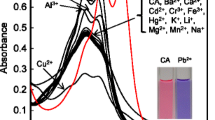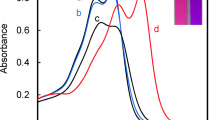Abstract
We have developed a colorimetric chemosensor for the selective and sensitive detection of Cys based on the complex (CA-2Pb2+) between a commercially available natural organic dye, carminic acid (CA) and Pb2+ in pure aqueous solution at physiological pH. The addition of Cys to the CA-2Pb2+ solution resulted in a distinct color change from purple to red together with a remarkable absorption spectral change by the restoration of CA through a displacement mechanism with formation of the Cys-Pb2+ complex, whereas other amino acids and glutathione induce no or minimal spectral and color changes. Moreover, the other amino acids and GSH do not affect the detection ability of CA-2Pb2+ for Cys. The reversibility even through several cycles was established for practical applications. The results indicate that CA-2Pb2+ may be useful as a potential colorimetric and naked-eye chemosensor for Cys over Hcy and GSH in aqueous solution.







Similar content being viewed by others
References
Cooper, A.J.: Biochemistry of sulfur containing amino acids. Ann. Rev. Biochem. 52, 187–222 (1983)
Wood, Z.A., Schroder, E., Harris, J.R., Poole, L.B.: Structure, mechanism and regulation of peroxiredoxins. Trends Biochem. Sci. 28, 32–40 (2003)
Lill, R., Mühlenhoff, U.: Iron–sulfur protein biogenesis in eukaryotes: components and mechanisms. Annu. Rev. Cell Dev. Biol. 22, 457–486 (2006)
Weerapana, E., Wang, C., Simon, G.M., Richter, F., Khare, S., Dillon, M.B.D., Bachovchin, D.A., Mowen, K., Baker, D., Cravatt, B.F.: Quantitative reactivity profiling predicts functional cysteines in proteomes. Nature. 468, 790–795 (2010)
Dalton, T.P., Shertzer, H.G., Puga, A.: Regulation of gene expression by reactive oxygen. Annu. Rev. Pharmacol. Toxicol. 39, 67–101 (1999)
Chai, G.S., Jiang, X., Ni, Z.F., Xie, A.J., Cheng, X.S., Wang, Q., Wang, J.Z., Liu, G.P.: Betaine attenuates alzheimer-like pathological changes and memory deficits induced by homocysteine. J. Neurochem. 124, 388–396 (2013)
Wang, X.F., Cynader, M.S.: Pyruvate released by astrocytes protects neurons from copper-catalyzed cysteine neurotoxicity. J Neurosci. 21, 3322–3331 (2001)
Go, Y.M., Jones, D.P.: Cysteine/cystine redox signaling in cardiovascular disease. Free Radic. Biol. Med. 50, 495–509 (2011)
Moreira, P.I., Harris, P.L.R., Zhu, X.W., Santos, M.S., Oliveira, C.R., Smith, M.A., Perry, G.: Lipoic acid and N-acetyl cysteine decrease mitochondrial-related oxidative stress in Alzheimer disease patient fibroblasts. J. Alzheimer’s Dis. 12, 195–206 (2007)
Ahmed, K.B.A., Sengan, M., Kumar, S., Veerappan, A.: Highly selective colorimetric cysteine sensor based on the formation of cysteine layer on copper nanoparticles. Sens. Actuators B. 233, 431–437 (2016)
Tcherkas, Y.V., Denisenko, A.D.: Simultaneous determination of several amino acids, including homocysteine, cysteine and glutamic acid, in human plasma by isocratic reversed-phase high-performance liquid chromatography with fluorimetric detection. J. Chromatogr. A. 913, 309–313 (2001)
Kataoka, H., Takagi, K., Makita, M.: Determination of total plasma homocysteine and related aminothiols by gas chromatography with flame photometric detection. J. Chromatogr. B. 664, 421–425 (1995)
Ge, S., Yan, M., Lu, J., Zhang, M., Yu, F., Yu, J., Song, X., Yu, S.: Electrochemical biosensor based on graphene oxide—Au nanoclusters composites for l-cysteine analysis. Biosens. Bioelectron. 31, 49–54 (2012)
Vieira, I.C., Filho, O.F.: L-Cysteine determination using a polyphenol oxidase-based inhibition flow injection procedure. Anal. Chim. Acta. 399, 287–293 (1999)
Guo, H., Jing, Y., Yuan, X., Ji, S., Zhao, J., Li, X., Kan, Y.: Highly selective fluorescent OFF-ON thiol probes based on dyads of BODIPY and potent intramolecular electron sink 2,4-dinitrobenzenesulfonyl subunits. Org. Biomol. Chem. 9, 3844–3853 (2011)
Yan, Z., Guang, S., Xu, H., Liu, X.: An effective real-time colorimetric sensor for sensitive and selective detection of cysteine under physiological conditions. Analyst. 136, 1916–1921 (2011)
Kim, Y.S., Park, G.J., Lee, S.A., Kim, C.: A colorimetric chemosensor for the sequential detection of copper ion and amino acids (cysteine and histidine) in aqueous solution. RSC Adv. 5, 31179–31188 (2015)
Liu, X., Yang, D., Chen, W., Yang, L., Qi, F., Song, X.: A red-emitting fluorescent probe for specific detection of cysteine over homocysteine and glutathione with a large Stokes shift. Sens. Actuators B. 234, 27–33 (2016)
Wang, F., Guo, Z., Li, X., Li, X., Zhao, C.: Development of a small molecule probe capable of discriminating cysteine, homocysteine, and glutathione with three distinct turn-on fluorescent outputs. Chem. Eur. J. 20, 11471–11478 (2014)
Fan, W., Huang, X., Shi, X., Wang, Z., Lu, Z., Fan, C., Bo, Q.: A simple fluorescent probe for sensing cysteine over homocysteine and glutathione based on PET. Spectrochim Acta A. 173, 918–923 (2017)
Wu, J., Kwon, B., Liu, W., Anslyn, E.V., Wang, P., Kim, J.S.: Chromogenic/fluorogenic ensemble chemosensing systems. Chem. Rev. 115, 7893–7943 (2015)
Nguyen, B.T., Anslyn, E.V.: Indicator–displacement assays. Coord. Chem. Rev. 250, 3118–3127 (2006)
Gil, E.S., Oliveira, S.C., Oliveira-Brett, A.M.: Hydroxyanthraquinones carminic acid and chrysazin anodic oxidation. Electroanalysis. 24, 2079–2084 (2012)
Nevado, J.J.B., Cabanillas, C.G., Salcedo, A.M.C.: Simultaneous spectrophotometric determination of three food dyes by using the first derivative of ratio spectra. Talanta. 42, 2043–2051 (1995)
Cabrera, R.B., Fernandez-Lahore, H.M.: Primary recovery of acid food colorant. Int. J. Food Sci. Technol. 42, 1315–1326 (2007)
Wanga, F., Huanga, W., Li, K., Li, A., Gao, W., Tang, B.: Study on the fluorescence enhancement in Lanthanum(III)–carminic acid–cetyltrimethylammonium bromide system and its analytical application. Spectrochim. Acta A. 79, 1946–1951 (2011)
López-Martinez, L., Guzman-Mar, J.L., Lopez-de Alba, P.L.: Simultaneous determination of uranium(VI) and thorium(IV) ions with carminic acid by bivariate calibration. J. Radioanal. Nucl. Chem. 247, 413–417 (2001)
Sakamaki, M., Aikawa, S., Fukushima, Y.: Colorimetric determination of Pb2+ in perfect aqueous solution using carminic acid as a selective chemosensor. J. Fluoresc. 27, 1929–1935 (2017)
Irving, H.M.N.H., Freiser, H., West, T.S.: IUPAC Compendium of Analytical Nomenclature, Definitive Rules. Pergamon Press, Oxford (1978)
Jalilehvand, F., Sisombath, N.S., Schell, A.C., Facey, G.A.: Lead(II) complex formation with L-cysteine in aqueous solution. Inorg. Chem. 54, 2160–2170 (2015)
Crea, F., Falcone, G., Foti, C., Giuffre, O., Materazzi, S.: Thermodynamic data for Pb2+ and Zn2+ sequestration by biologically important S-donor ligands, at different temperatures and ionic strengths. New J. Chem. 38, 3973–3983 (2014)
You, G.R., Lee, J.J., Choi, Y.W., Lee, S.Y., Kim, C.: Experimental and theoretical studies for sequential detection of copper(II) and cysteine by a colorimetric chemosensor. Tetrahedron. 72, 875–881 (2016)
Lee, S.A., Lee, J.J., Shin, J.W., Min, K.S., Kim, C.: A colorimetric chemosensor for the sequential detection of copper(II) and cysteine. Dyes Pigm. 116, 131–138 (2015)
Singh, Y., Arun, S., Singh, B.K., Dutta, P.K., Ghosh, T.: Colorimetric and ON–OFF–ON fluorescent chemosensor for the sequential detection of Cu(II) and cysteine and its application in imaging of living cells. RSC Adv. 6, 80268–80274 (2016)
Yang, L., Qu, W., Zhang, X., Hang, Y., Hua, J.: Constructing a FRET-based molecular chemodosimeter for cysteine over homocysteine and glutathione by naphthalimide and phenazine derivatives. Analyst. 140, 182–189 (2015)
Job, P.: Formation and stability of inorganic complexes in solution. Ann. Chim. Puris. 9, 113–203 (1928)
Author information
Authors and Affiliations
Corresponding author
Rights and permissions
About this article
Cite this article
Inoue, K., Aikawa, S. & Fukushima, Y. Colorimetric chemosensor based on a carminic acid and Pb2+ complex for selective detection of cysteine over homocysteine and glutathione in aqueous solution. J Incl Phenom Macrocycl Chem 90, 105–110 (2018). https://doi.org/10.1007/s10847-017-0772-y
Received:
Accepted:
Published:
Issue Date:
DOI: https://doi.org/10.1007/s10847-017-0772-y




